Protect Yourself and Your Staff: Infection control best practices for dental team members
Proper infection control procedures are critical components to any dental practice. Observing best practices ensures not only patient safety but also that of the team. Ideally, every practice would identify these behaviors and weed them out.

Proper infection control procedures are critical components to any dental practice. Observing best practices ensures not only patient safety but also that of the team. Ideally, every practice would identify these behaviors and weed them out.
The often overlooked
Some missteps appear insignificant – so much so that it seems they don’t matter. However, that is not the case, and some of these tiny infractions are actually very important.
“Team members are so accustomed to wearing masks that sometimes they fail to wear it correctly,” Mary Borg-Bartlett, President SafeLink Consulting says. “Examples would be a mask that is not pulled up over the nose or crisscrossing the straps over the ear to make the mask fit tighter. Team members need to remind each other when they see a mask or any type of PPE [personal protective equipment] not being worn correctly. Inhalation is an entry route that must be protected when there is spray or splatter during a dental procedure. This means that not covering the nose is a possible route of entry. If a mask is too large, then smaller masks should be provided.”
Another seemingly inconsequential habit is the manner in which clinical staff puts on and removes personal protective equipment.
“It's a good practice to review the correct way to don and doff PPE,” Borg-Bartlett says. “The CDC has a poster that shows the correct way. Use this poster in a team huddle for training. Another suggestion for training is to have a team member demonstrate how they don and doff the PPE. Of course, select someone who won’t mind being critiqued by other team members. Observe team members removing a mask after patient treatment. It should be removed by the strap over the ear by using the finger. It’s not uncommon to see someone grab the mask in the front to remove it. The mask is the last item to be removed and could be contaminated.
Continued on next page…
Common mistakes
Unfortunately, some practices tend to fall into bad habits. These missteps may seem small and insignificant, but they are still contrary to good infection control protocol.
In recent years, for example, well-publicized infection control breaches have occurred because dental unit waterlines were contaminated. Ensuring those water lines are properly maintained should not be overlooked.
“Dental unit waterlines (i.e., plastic tubing that carries water to the high-speed handpiece, air/water syringe, and ultrasonic scaler) promote bacterial growth and development of biofilm due to the presence of long narrow-bore tubing, inconsistent flow rates, and the potential for retraction of oral fluids,” the CDC’s Summary of Infection Prevention Practices in Dental Settings: Basic Expectations for Safe Care website reads. “Dental health care personnel and patients could be placed at risk of adverse health effects if water is not appropriately treated.
“All dental units should use systems that treat water to meet drinking water. Independent reservoirs – or water-bottle systems – alone are not sufficient. Commercial products and devices are available that can improve the quality of water used in dental treatment,” the website continues. “Consult with the dental unit manufacturer for appropriate water maintenance methods and recommendations for monitoring dental water quality. During surgical procedures, use only sterile solutions as a coolant/irrigant using an appropriate delivery device, such as a sterile bulb syringe, sterile tubing that bypasses dental unit waterlines, or sterile single-use devices.”
The CDC issued the following recommendations:
- Use water that meets EPA regulatory standards for drinking water (i.e., ≤ 500 CFU/mL of heterotrophic water bacteria) for routine dental treatment output water.
- Consult with the dental unit manufacturer for appropriate methods and equipment to maintain the quality of dental water.
- Follow recommendations for monitoring water quality provided by the manufacturer of the unit or waterline treatment product.
- Use sterile saline or sterile water as a coolant/irrigant when performing surgical procedures.
Another issue that can arise is the way in which surfaces are disinfected, which may seem straightforward enough, but is one of the most common blunders.
Related reading: 3 common infection control questions answered
“Disinfecting wipes are used frequently now in dental practices to clean rooms after patient treatment or cleaning surfaces in the sterilization area,” Borg-Bartlett says. “When using liquid spray disinfectants, the ‘spray-wipe-spray’ method is used. First, the countertop is sprayed, then wiped with a paper towel, and then sprayed again and left wet. Now that disinfecting wipes are used, only one step is typically being performed. On the container of the wipe, it may even state that it’s a ‘one step’. Read more carefully on the container and it states that the one-step is on a pre-cleaned surface. This means wipe the counter, dispose of the wipe, and wipe again with a second, thoroughly wet wipe.”
It may be cliché, but the saying, “When in doubt, read the instructions” is particularly good advice where infection control matters are concerned.
“It's so important to read the labels on all products to ensure that they are being used correctly,” Borg-Bartlett says. “Reading the Safety Data Sheet for the product can also be helpful in determining the correct PPE to be worn when using the product. The label or SDS [safety data sheet] on some of the disinfecting wipes states to wear butyl rubber or nitrile gloves. This would mean that a latex glove is not adequate protection.”
Continued on next page…
Best practices
Of course, there are procedures that practices must follow, like the instances of percutaneous injuries, hand hygiene, and needlestick or sharps injuries. Ongoing education is a crucial remedy for some of these occurrences, according to the CDC.
“Ongoing education and training of DHCP are critical for ensuring that infection prevention policies and procedures are understood and followed,” the CDC’s summary says. “Education on the basic principles and practices for preventing the spread of infections should be provided to all DHCP. Training should include both DHCP safety (e.g., OSHA bloodborne pathogens training) and patient safety (e.g., emphasizing job or task-specific needs). Education and training should be provided during orientation to the setting, when new tasks or procedures are introduced and at a minimum, annually. Training records should be maintained according to state and federal requirements.”
To achieve that goal, the CDC recommends practices to:
- Provide job or task-specific infection prevention education and training to all DHCP. This includes those employed by outside agencies and those available by contract or on a volunteer basis to the facility.
- Provide training on principles of both DHCP safety and patient safety.
- Provide training during orientation and at regular intervals.
- Maintain training records according to state and federal requirements.
Some confusion still exists on when to wear PPE under certain circumstances, but the CDC and OSHA offer guidance.
“Whenever spray or spatter could be generated during patient treatment, the dentist, dental assistant, and dental hygienist must wear either a fabric or disposable garment,” Borg-Bartlett says. “It should cover their scrubs or street clothes and their skin. OSHA states…that the sleeves must be long enough to protect the forearms.
“This type of PPE must be changed when it becomes visibly soiled and as soon as feasible if penetrated by flood or other potentially infectious fluids,” she continues. “This PPE can be laundered at the dental practice or sent out for laundering by a commercial service but cannot be taken home by the dentist or the staff for laundering.”
In their 2016 summary of infection prevention, the CDC stated that hand hygiene is the most important step in preventing the spread of infections, Borg-Bartlett says.

Good hand hygiene is a simple task that gets taken for granted. Yet, the proper procedure exists and should always be observed. In their 2016 summary of infection prevention, the CDC stated that hand hygiene is the most important step in preventing the spread of infections, Borg-Bartlett says.
“Good hand hygiene practices are so important to prevent not only exposure to team members but also to patients,” Borg-Bartlett says. “Hands should be washed before gloving, immediately after removing gloves, prior to using the restroom, after using the restroom, and before and after lunch breaks. The CDC recommends using water and plain soap after routine exams and nonsurgical procedures or an alcohol-based hand rub. For surgical procedures, the CDC recommends a surgical hand scrub be used before putting on sterile surgeon’s gloves.”
If an infection control breach does occur, staff must respond in a specific, prescribed way. Percutaneous injuries, while frightening, are on the rise, according to the CDC summary, and these injuries pose the risk of bloodborne pathogen transmission, Borg-Bartlett says. For these cases, practices must have the OSHA post-exposure evaluation and follow-up procedures in place, she says.
“OSHA’s post-exposure evaluation and follow-up procedure must be implemented as quickly as possible. When this incident occurs, it’s much easier to explain it to the patient while they are in the office rather than having to call them later,” Borg-Bartlett says.
Plus, she continued, it’s important that the team member who received the injury must have the chance to start post-exposure prophylaxis.
“Since the team member who receives the percutaneous injury must be offered blood testing, the practice must refer them to a medical facility for this treatment,” Borg-Bartlett says. “All clinics and physicians don’t treat these types of exposures; therefore, the practice needs to call medical providers in their area to find one before this type of injury occurs.”
Observing the correct infection prevention measures is necessary, not only for patient safety but also for the safety of staff. Sometimes, DHCP can fall into bad habits or they may simply not understand the proper procedures. However, it’s important to refresh staff on these measures to help prevent the spread of infections.